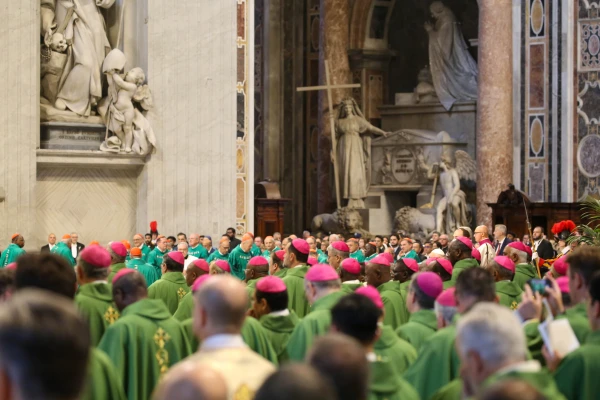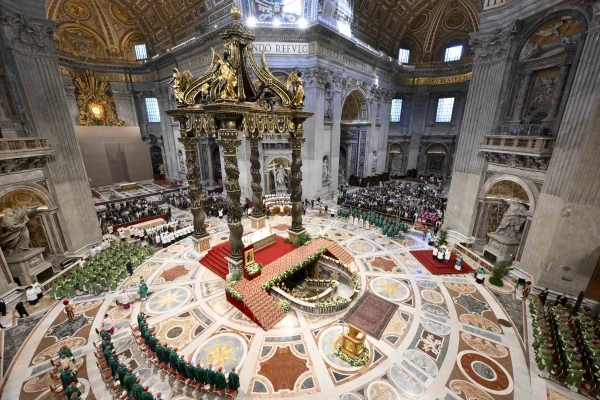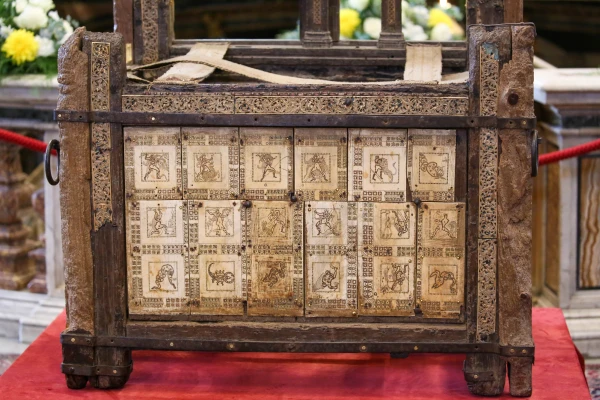Pope Francis closed the final assembly of the Synod of Synodality this Sunday, with a call for a Church that “listens to the cry of the world” without being “blind” to the urgent issues of our time.
At Mass in St. Peter’s Basilica, Pope Francis noted that a synodal Church must be “on the move” following Christ in service to those in need.
Receive the main news from ACI Prensa by WhatsApp and Telegram
It is increasingly difficult to see Catholic news on social media. Subscribe to our free channels today:
“We do not need a sedentary and defeatist Church, but a Church that listens to the cry of the world… and that gets its hands dirty by serving the Lord,” the Pope indicated in his homily on October 27.
Pope Francis stressed that the Church cannot remain inert in the face of “the questions raised by the men and women of today, the challenges of our time, the urgency of evangelization, and the many wounds that afflict humanity.”
“Brothers and sisters, not a sedentary Church, but a standing Church. Not a silent Church, but a Church that embraces the cry of humanity. Not a blind Church, but a Church illuminated by Christ, which brings the light of the Gospel to others. Not a static Church, but a missionary Church that walks with its Lord through the streets of the world,” he added.
The Mass marked the conclusion of the second assembly of the XVI Ordinary General Assembly of the Synod of Bishops, which began on October 2 and focused on the theme “For a synodal Church: communion, participation and mission.”
The assembly represented a significant phase in the Church’s global synodal process, which began three years ago. Over the past month, Synod delegates produced a 52-page final document that presents recommendations for the renewal of the Church, including proposals for greater participation of women in leadership roles, greater participation of lay people in decision-making , and significant structural reforms.
In a notable departure from tradition, Pope Francis announced that he will dispense with a post-synodal apostolic exhortation. Instead, he chose to ratify the final document of the Synod, directly implementing the conclusions of the assembly. While the synod assembly has concluded, 10 study groups will continue to examine the issue of deaconesses and other key issues until June 2025.
In his homily, Pope Francis reflected on the passage from the Gospel of Mark in which Jesus heals a blind man named Bartimaeus. He said that “blind Bartimaeus… represents that inner blindness that holds us back, stagnates us, prevents us from the dynamism of life, and destroys our hope.”

“So many things along the way can blind us, incapacitating us to perceive the presence of the Lord, or to face the challenges of reality, sometimes without being able to offer adequate answers to the questions of so many who cry out to us,” the Pope indicated.
“A sedentary Church, which inadvertently withdraws from life and limits itself to the margins of reality, is a Church that runs the risk of remaining blind and becoming comfortable with its own discomfort. “If we remain trapped in our blindness, we will continually fail to grasp the urgency of providing a pastoral response to the many problems of our world,” he added.
Pope Francis, dressed in green vestments for the 30th Sunday in Ordinary Time, delivered his homily slowly, pausing frequently to speak spontaneously. He described the image of a “Synodal Church” as one in which “the Lord calls us, lifts us up when we sit or fall, restores our sight so that we can perceive the anxieties and sufferings of the world in the light of the Gospel.”
“Let us remember to never walk alone or according to worldly criteria,” he added, but rather to move forward “following Jesus along the way.”
At the altar, Cardinal Mario Grech, secretary general of the General Secretariat of the Synod, was the main celebrant.
More than 300 priests and bishops, 70 cardinals and nine patriarchs concelebrated the closing Mass of the Synod under the recently restored baldachin above the central altar.

The 400-year-old bronze baldachin, designed by Gian Lorenzo Bernini, was revealed at Mass for the first time following its restoration, its glistening twisted columns decorated with intricately ornate baroque angels, cherubs, bees and gilded laurel branches.
“By admiring Bernini’s majestic baldachin, more sublime than ever, we can rediscover that it frames the true focal point of the entire basilica, which is the glory of the Holy Spirit,” the Pope said. “This is the synodal Church: a community whose primacy resides in the gift of the Spirit, who makes us brothers and sisters in Christ and lifts us up to Him.”
At the conclusion of the Mass, Pope Francis, from his wheelchair, led the faithful in the veneration of a relic of Saint Peter’s chair, a wooden throne that symbolizes papal primacy. This relic is expected to remain on display in St. Peter’s Basilica for public veneration until December 8.

“Today, as we thank the Lord for the path we have traveled together, we will be able to see and venerate the carefully restored relic of the ancient chair of Saint Peter,” commented Pope Francis. “As we contemplate it with the amazement of faith, let us remember that this is the chair of love, the chair of unity, and the chair of mercy.”
Translated and adapted by ACI Prensa. Originally published in CNA.

